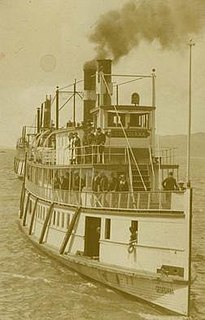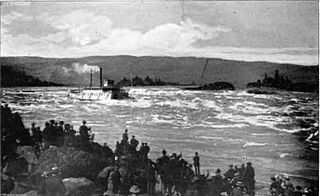
The Oregon Railroad and Navigation Company (OR&N) was a railroad that operated a rail network of 1,143 miles (1,839 km) of track running east from Portland, Oregon, United States to northeastern Oregon, northeastern Washington, and northern Idaho. The railroad operated from 1896 as a consolidation of several smaller railroads.
The Ilwaco Railway and Navigation Company operated a 3 ft narrow gauge railroad that ran for over forty years from the bar of the Columbia River up the Long Beach Peninsula to Nahcotta, Washington, on Willapa Bay. The line ran entirely in Pacific County, Washington, and had no connection to any outside rail line. The railroad had a number of nicknames, including the "Clamshell Railroad" and the "Irregular, Rambling and Never-Get-There Railroad."
The Shaver Transportation Company is an inland water freight transportation company based in Portland, Oregon, United States. The company was founded in 1880 and played a major role in the development of freight transport in the Portland area and along the Columbia.

Many steamboats operated on the Columbia River and its tributaries, in the Pacific Northwest region of North America, from about 1850 to 1981. Major tributaries of the Columbia that formed steamboat routes included the Willamette and Snake rivers. Navigation was impractical between the Snake River and the Canada–US border, due to several rapids, but steamboats also operated along the Wenatchee Reach of the Columbia, in northern Washington, and on the Arrow Lakes of southern British Columbia.

Georgiana was a propeller-driven steamboat that operated on the Columbia River from 1914 to 1940. Georgiana was built of wood, and specially designed for the Harkins Transportation Company, a steamboat line in which the wealthy Henry L. Pittock was a shareholder.

Lurline was a steamboat that served from 1878 to 1930 on the Columbia and Willamette rivers. Lurline was a classic example of the Columbia river type of steamboat.

R. R. Thompson was a large sternwheel steamboat designed in the classic Columbia River style. She was named after Robert R. Thompson, one of the shareholders of the Oregon Steam Navigation Company, the firm that built the vessel.

The sidewheeler Idaho was a steamboat that ran on the Columbia River and Puget Sound from 1860 to 1898. There is some confusion as to the origins of the name; many historians have proposed it is the inspiration for the name of the State of Idaho. Considerable doubt has been cast on this due to the fact that it is unclear if the boat was named before or after the idea of 'Idaho' as a territory name was proposed. John Ruckel also allegedly stated he had named the boat after a Native American term meaning 'Gem of the Mountains' he got from a mining friend from what is now Colorado territory. This steamer should not be confused with the many other vessels of the same name, including the sternwheeler Idaho built in 1903 for service on Lake Coeur d'Alene and the steamship Idaho of the Pacific Coast Steamship Line which sank near Port Townsend, Washington.

Charles R. Spencer was a steamboat built in 1901 to run on the Willamette and Columbia rivers from Portland, to The Dalles, Oregon. This vessel was described as an "elegant passenger boat". After 1911 this vessel was rebuilt and renamed Monarch.

General Miles was a steamship constructed in 1882 which served in various coastal areas of the states of Oregon and Washington, as well as British Columbia and the territory of Alaska. It was apparently named after US General Nelson A. Miles.

Sarah Dixon was a wooden sternwheel-driven steamboat operated by the Shaver Transportation Company on the Columbia and lower Willamette rivers from 1892 to 1926. Originally Sarah Dixon was built as a mixed use passenger and freight vessel, and was considered a prestige vessel for the time.

Montesano was a steamboat that was operated from 1882 to about 1903 in the coastal regions of Oregon and southwest Washington, including Astoria, Willapa Bay, Grays Harbor, the Chehalis River, Yaquina Bay and Coos Bay. The Montesano of 1882, built in Astoria, should not be confused with another, larger sternwheeler, also named Montesano, built in Cosmopolis, Washington in 1889.

Ocean Wave was a steamboat that was operated from 1891 to 1897 on the Columbia River, from 1897 to 1899 on Puget Sound and from 1899 to 1911 as a ferry on San Francisco Bay. Ocean Wave is perhaps best known for transporting summer vacationers from Portland, Oregon to seaside resorts near Ilwaco, Washington during its service on the Columbia River. This vessel is also known for being the first ferry placed in service by the Atchison, Topeka and Santa Fe Railway.

Emma Hayward commonly called the Hayward, was a steamboat that served in the Pacific Northwest. This vessel was once one of the finest and fastest steamboats on the Columbia River and Puget Sound. As newer vessels came into service, Emma Hayward was relegated to secondary roles, and, by 1891, was converted into a Columbia river tow boat.

John H. Couch was a side-wheel driven steamboat that operated on the Columbia and lower Willamette rivers from 1863 to 1873. Informally the vessel was known as the Couch.

No Wonder was a stern-wheel driven steamboat that operated on the Willamette, Columbia and Cowlitz rivers from 1889 to 1930. No Wonder was originally built in 1877 as Wonder, which was dismantled in 1888, with components being shifted over to a new hull, which when launched in late 1889 was called No Wonder.

Governor Newell was a sternwheel-driven steamboat that operated from 1883 to 1902 in the Pacific Northwest.



































